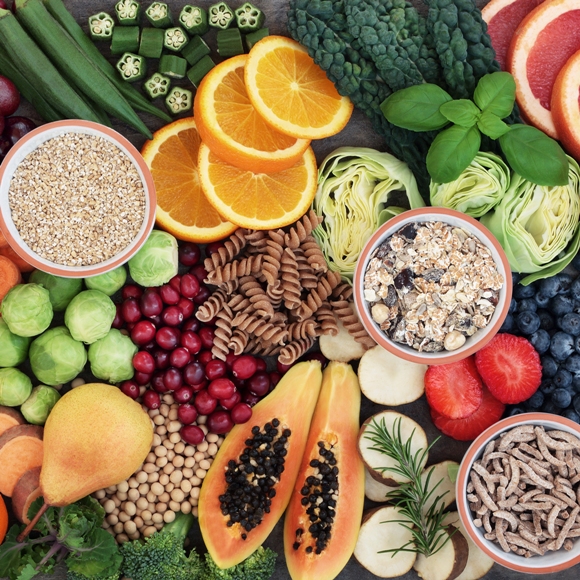
When it comes to a healthy lifestyle and eating for preventing disease, some things are so easy to do I want to stand on top of the tallest building with a bullhorn and scream, “Yes, you can do it!”
You have probably heard fiber is good for preventing constipation, right? In addition, research has demonstrated that individuals with a high intake of dietary fiber are at significantly lower risk for developing heart disease, stroke, hypertension, diabetes, obesity and certain gastrointestinal diseases. In spite of these findings, the average fiber intake for U.S. children and adults is less than half of the recommended levels.
Dietary fiber comes from the roughage in our food. Our bodies cannot absorb or digest it. Instead fiber passes through our bodies relatively intact, imparting some amazing and healthy benefits. Fiber is classified as either soluble (it dissolves in water) or insoluble (it doesn’t dissolve), each contributing to unique and specific benefits. Soluble fiber can help lower blood cholesterol and glucose levels. Insoluble fiber promotes the movement of material through your digestive system and increases stool bulk, so it can be of benefit to those who struggle with constipation or irregular stools. The good thing is most plant-based foods contain both types of fiber.
One of the most interesting things about fiber is how it can help you lose weight and maintain a healthy weight. Fiber contains calories, however these calories are virtually invisible to your body and will not contribute to weight gain. This healthy carbohydrate cannot be digested and what goes in just works its way out the other end.
Here is something to ponder – let’s say you eat one serving of breakfast cereal that has “0” grams of fiber. These are very easy to find as most cereals have little to no fiber, such as Rice Krispies. Now let’s compare this to a cereal such as Fiber One that has 14 grams of fiber. Most of what is in cereal, including fiber, is carbohydrates (some healthy and others not so). Each gram of carbohydrates contains 4 calories. Just for easy comparison, let’s say each of these cereals contain 100 calories per serving. The rice cereal allows your body to digest the full 100 calories, much of it going to fat storage. But the 14 grams of fiber in the Fiber One cereal equals 56 invisible calories. That high fiber cereal only has 44 calories for your body to see. A 56 calorie savings may not seem like much, but just think about if you do this day after day. In one year, you will lose more than 10 pounds with no effort at all. In addition, what if you don’t stop at breakfast, but add high fiber foods throughout your day? You will lose far more weight. Foods rich in fiber can add bulk without adding calories, increasing a sense of fullness. In addition, as these foods require more chewing time, they can allow you to register when you’re no longer hungry, so you’re less likely to overeat.
If that was not enough to get you to start eating more fiber, here are other great reasons: a high fiber diet normalizes bowel movements, helps maintain bowel health, lowers cholesterol levels, helps control blood sugar levels (reducing your risk of Type 2 Diabetes) and significantly reduces the risk of heart disease. Research is a bit inconclusive, but there is strong evidence that a high fiber diet will also help prevent colon cancer, breast cancer, ovarian cancer and uterine cancer.
How much fiber do you need each day? The Institute of Medicine, which provides science-based advice on matters of medicine and health, gives the following daily recommendations for adults: Men age 50 or younger, 38 grams; older than 51, should have 30 grams; women who are 50 or younger, 25 grams; older than 51, should have 21 grams.
If you aren’t getting enough fiber each day, you may need to boost your intake. Here is where you will find the best sources — whole-grain products, fruits, vegetables, beans, peas and other legumes, nuts and seeds. Refined or processed foods — such as canned fruits and vegetables, pulp-free juices, white breads and pastas, and non-whole-grain cereals — are lower in fiber. The grain-refining process removes the outer coat (bran) from the grain, which lowers its fiber content. Similarly, removing the skin from fruits and vegetables decreases their fiber content.
Always worrying about heart disease, one of my favorite sources of fiber comes from oats. Oats are loaded with both soluble (for bad cholesterol reduction) and insoluble fiber. The healthiest form of this super food is steel cut oats. The problem is they usually take 30 or more minutes to cook, way to slow for a fast breakfast.
This article was contributed by Dr. Stuart Offer.
 Related Articles & Free Subscription
Related Articles & Free Subscription
Do You Need to Take a Dietary Supplement?




Comment here